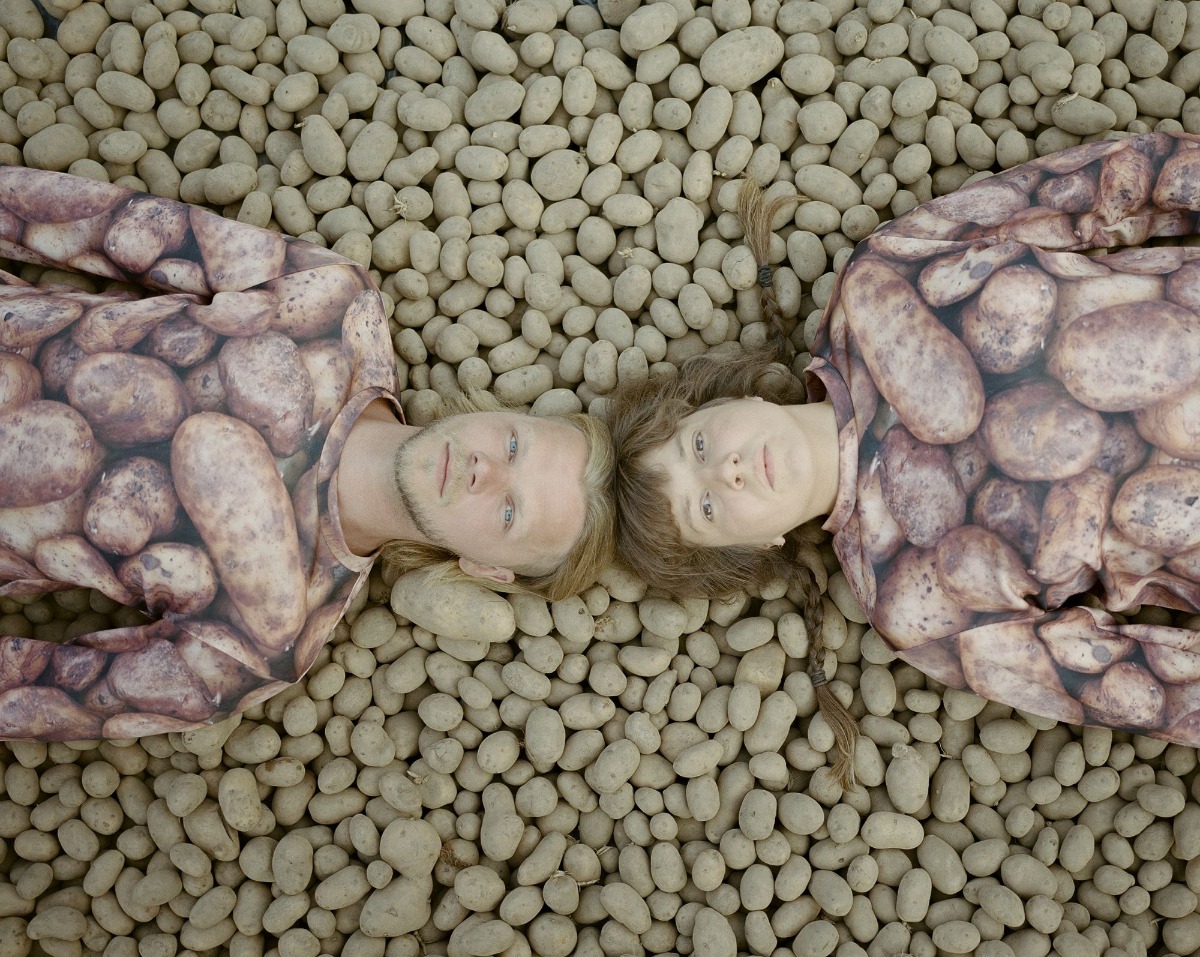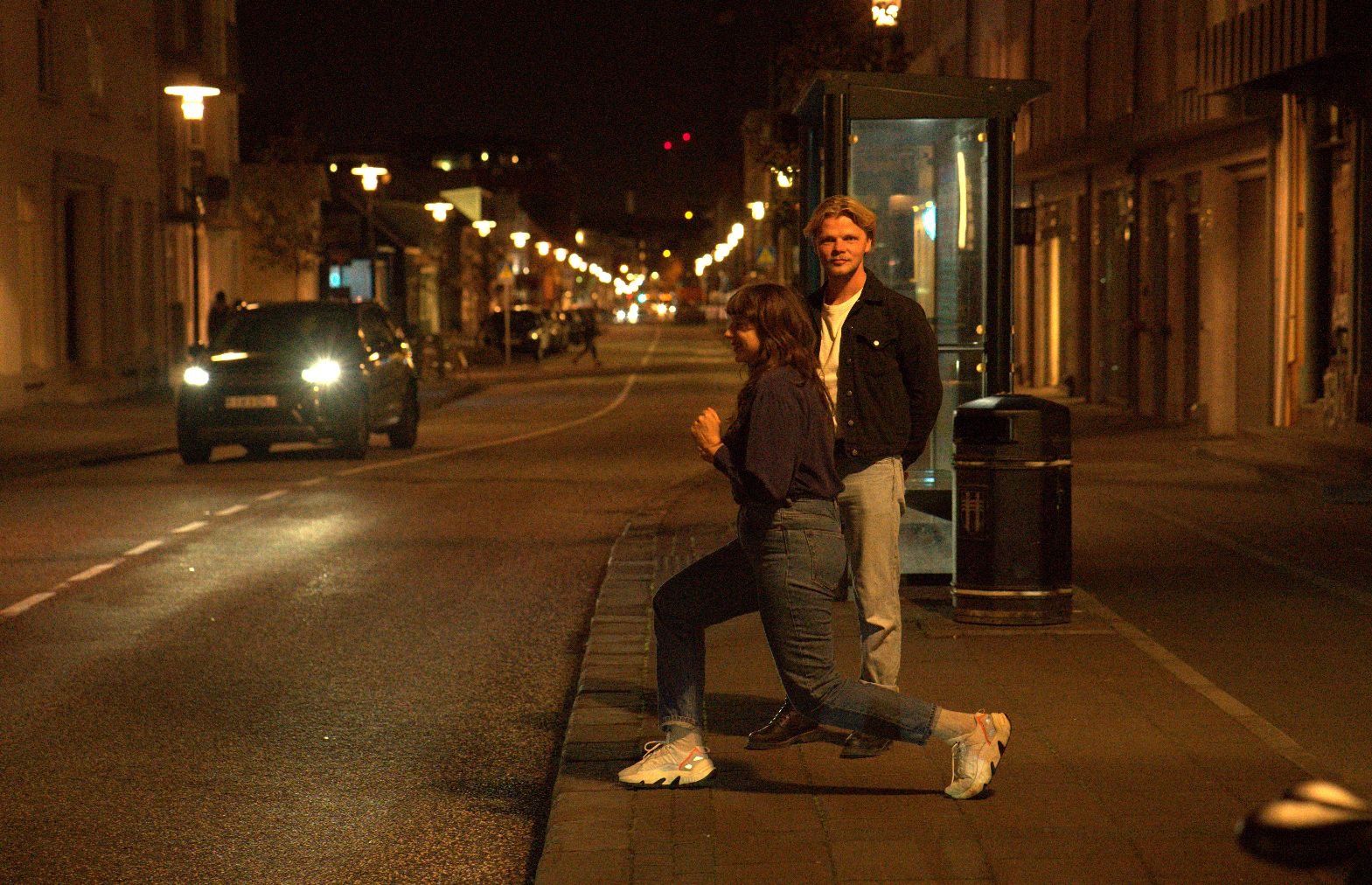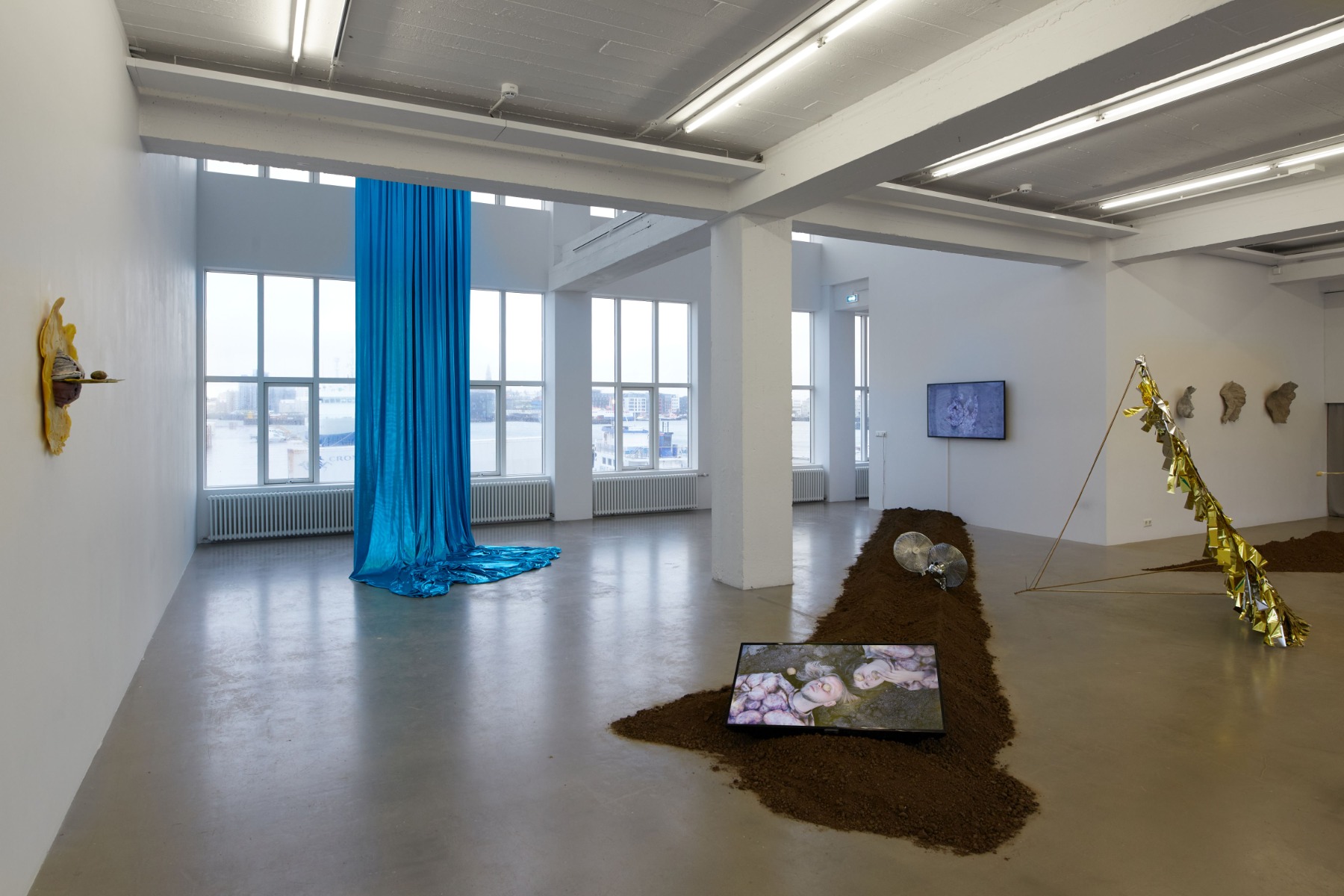
This is something really special now
Gundega Šķēla
An interview with the artist duo Renāte Feizaka and Klāvs Liepiņš
Renāte Feizaka (b. 1987) and Klāvs Liepiņš (b.1991) are an artist duo originally from Latvia but now based in Iceland. Both are graduates of the Iceland University of the Arts, with Klāvs holding a BA in Contemporary Dance and Renāte a BA in Fine Arts.
In their collaboration, the artists combine Renāte’s installations and sculptures with Klāvs’ movement and choreography to create videos, performances and installations. In their works they transform their own physical appearance into characters so as to explore themes of identity, nationality, and cultural structures that shape individuals and society as a whole.
Their 2022 exhibition As you are now so once was I/As I am now so will you be at The Living Art Museum, NÝLO in Reykjavik, Iceland, was nominated for the Icelandic Art Prize. This October they will continue their artistic work with a show at the Reykjavik Art Museum, Hafnarhús.
It seems like your cooperation in art is like that of siblings. When and how did it start?
Klāvs: I don’t think there is a very certain starting point. We started as friends and then just helped each other with art because we both did art. The first time was when Renāte helped with my music video.
Renāte: Yes, but with the music video it was really interesting because I felt like we are not a good match. I cried [laughs], a lot. I cried because Klāvs was changing my idea and I was not okay with that.
K: I didn’t know that...
R: After taking some breaks, we filmed the video. At that point I had developed my artistic practice more, and Klāvs had as well. At that moment, it felt easy and magical. I realised that this is something really special now.
K: We first met in Iceland in 2014, but I believe it was in 2018 when we began collaborating.
R: We met in the smoking area of Kafibarinn [a legendary night club in Iceland – G.Š.].
R: It all started when I was working on my solo show, and I wanted Klāvs to participate in my video. It was then that I realised that this was actually a collaborative work. Filming Traces of Red was such a magical experience.
K: But there was never the intention to start an artist duo. We just started doing things together.
Traces Of Red from Klāvs Liepiņš on Vimeo.
What is your approach when working together?
R: I feel like video is where we meet, and we each bring our own strengths and interests. I play with installations and sculptures, while Klāvs focuses on movement and choreography. And then we merge it all together. But there are no roles nor rules in our collaboration. For example, when we are at Klāvs’ studio in the middle of the forest in Latvia, we tend to brainstorm independently and then have a meeting to pitch our ideas. Afterward, we decide what works and what doesn’t, and whether we truly understand each other. The understanding between us is usually very natural..
K: What I appreciate about our collaboration is that we are not afraid to disagree with each other. It may lead to uncomfortable situations with arguments, but it really helps us to peel off the layers and delve deeper into the topic. This is because we share a very similar aesthetic and vision for the outcome of our artwork. We are of the same generation and we have a lot in common, but we don’t aim for compromise. Thus, we sometimes fight, which I really value.
What does this cooperation mean to you?
R: I believe that this just keeps the challenge alive. We are always asking ourselves, ‘What do we do next?’ This helps us stay on track with our development.
K: I also work as an individual artist, and at times that feels a bit overrated. Often I feel very lonely as a solo artist. When Renāte and I collaborate as a duo, there is so much power in two voices coming together. Of course, I am still interested in sharing and creating my solo work. However, when I think about what it means to me to have a duo with Renāte, it provides a more powerful way of dealing with the topics or whatever we are dealing with together. It allows us to go deeper.
R: It’s also so much work! I cannot imagine creating alone the scale of work that we have been making together. I would lose my mind. It’s physically, mentally, and creatively a really heavy load. I couldn’t handle it alone. I wouldn’t even want to go through it alone.
K: And at the end of the day, it’s just way more fun. Not as entertainment, but for us as individuals to create something together.
Hyperconnectivity from Klāvs Liepiņš on Vimeo.
You often incorporate your physical and visual appearance in your works. Why is that?
R: We definitely use our bodies as vessels. It’s never us in those videos. It’s always the characters with their identities and their stories. It might seem like it’s us, but it’s actually not.
K: I studied contemporary dance, so my body has always been the medium or the tool that I work with. Also, in my individual work my interest is very much about the body as a biological substance.
R: I have always been interested in anthropology, human living, and what creates identity. It’s also just easier to direct our own bodies than somebody else’s, because we don’t have to explain.
Your works often explore themes of identity and self-reflection. What roles do Iceland and Latvia play in your work when exploring these issues?
K: We both have our reasons for moving to Iceland. After a few years of living here, I started to realise how relative identity is, how ever-changing it is. When I lived only in Latvia, I was just whoever I was. If you’re always in the same environment without experiencing others, you are limited with that perception of oneself.
Leaving Latvia led to a transition period in which I wanted to push the previous away and felt rather hateful. After a few years in Iceland, I started to see how my identity was changing and adapting to this new environment, and how it could be shaped in whatever form. This realisation allowed me to look back and see how our identities in Latvia were created by factors like religion, by the post-soviet...
Living in Iceland, which has a different history and an absolutely different environment, has given me a different perspective. By bringing our stories and exhibiting them here, we can educate and provide more information on the experiences of our generation in Latvia. Because the social reality and the public discourse on these issues in Iceland is very different from the one in Latvia.
R: Honestly, as someone from Riga who went through the classical art education system which prepares you for art university, it felt like a very closed circle with many limitations. I didn’t feel brave enough to talk about the subjects I truly wanted to explore – like nationality, Christianity, and the Catholic Church. But now that I have some distance, I feel more able to explore weightier subjects. I’m not sure why I couldn’t do that in Latvia, but I can do it here. I suppose it’s the distance.
K: I agree. The environment in Iceland, and the way society talks about social issues, allows us to talk with greater ease about the subjects important to us. However, we do not address the society here as we would if we were in Latvia. People in Iceland do not take it personally, because it’s not their story and not their history, so it’s just so much easier for us to play with it and have...fun.
Klāvs and Renāte on the streets of Reyakjvik, 2022. Photo: Vikram Pradhan

How has the Icelandic audience responded to your work, given that the country has a different history and cultural context than Latvia? For instance, Renāte’s video piece Traces Of Red, which features symbols depicting the Soviet era.
R: Well, we were nominated for an Icelandic Art Prize, so the feedback has been wonderful. Actually, when we did the show As you are now so once was I/As I am now so will you be at The Living art museum, we made a rule to educate ourselves in nationalism and national identities in preparation for a backlash because we were asking such weighty questions.
You often choose basic, direct and down-to-earth tools – like potatoes, soil, and your physical body – to convey these themes in a humorous and even sarcastic manner. Does humor help to address difficult and complex issues?
R: It just helps to balance the heaviness of the themes we sometimes choose to uncover. It lightens things up. We don’t take ourselves too seriously. But we never have the intention to make fun of anything – it rather happens through exploration.
K: Exactly. I think the main thing is to not take ourselves too seriously and not put too much weight on the topic, but yet bring the topic to the table and to have a conversation. Using humor is just one way people can talk about heavy things. I think humor is always a way to look at life. Even when the biggest shit is happening, what can you do other than just have a little laugh? It’s about not taking yourself too seriously but still dealing with issues.
You were nominated for the Icelandic Art Prize and now have an upcoming exhibition at the Reykjavik Art Museum. What does recognition mean to you, and what can we expect?
R: It just gave a beautiful boost. And it gave me this sense of feeling that what we are doing is meaningful and important not only for myself. Also, that we have been seen.
K: ...seen and validated. We are humans and we need validation in one way or another. It was like – everything that we did before just got cemented. The recognition hasn’t changed our artistic practice much, but it has put a bit of fire under our asses to use this time and opportunity. So that with not too much stress, we can continue to evolve and keep on evolving.
R: The space at the Reykjavik Art Museum is a very different space from what we had before, as there are only three relatively small windows. In our last show, the space was filled with windows, so we had to focus on installation to preserve the magic of the exhibition space. Now, at least at this hour, it’s very exciting for me because we can focus on our video works and manipulate the light sources in the new space. We try to have unintentional choreography of the space – because the space matters.
K: The space is always a playground member of our exhibition. The space itself possesses an element that has its own life and is already present. We are not just stuck with our vision because the artwork’s outer impact and influence, which is the space, also has an effect.
We’re at the very, very beginning stage of the work for the upcoming show, and we both know that. We want to work with the space and use it to create an environment that allows the viewer to truly escape reality.
Identity is still a subject we enjoy exploring and investigating, continuously experiencing and observing how it filters through our artistic practices. We don’t know if it will stay, but this is our starting point. From a different perspective, moving away from spirituality... We’re just very excited to see where it will lead us.
As you are now so once was I/As I am now so will you be at The Living Art Museum, NÝLO in Reykjavik, Iceland in 2022. Photo: Vigfús Birgisson
Finally, what makes you happy?
R: My work, and I’m not joking. I was thinking my one true love is my work, my artistic practice, and my current work in the film industry. As a woman, I feel like that’s the one thing that nobody can take away from me – my drive, my passion, and my success.
Running by the ocean with music by Fred Again playing on my headphones. Practicing Brazilian jiu-jitsu makes me happy. Friends and a lot of wine. Recently, it has been love poetry.
K: Gardening, but it’s more than just gardening to me. It’s about being close to the cycles of life and stepping away from social constructs and human inventions to be closer to nature. Dogs always make me happy. I am obsessed with them.
A sense of belonging. I recently realised the importance of a sense of belonging. I have been thinking so much about how I want to be strong and individual, but that’s a lonely place. I have come to appreciate and be grateful for the feeling of being part of a community and the environment.
Potato People from Klāvs Liepiņš on Vimeo.
Title image: Potato Beauty, 2021. Photo: Sandis Liass